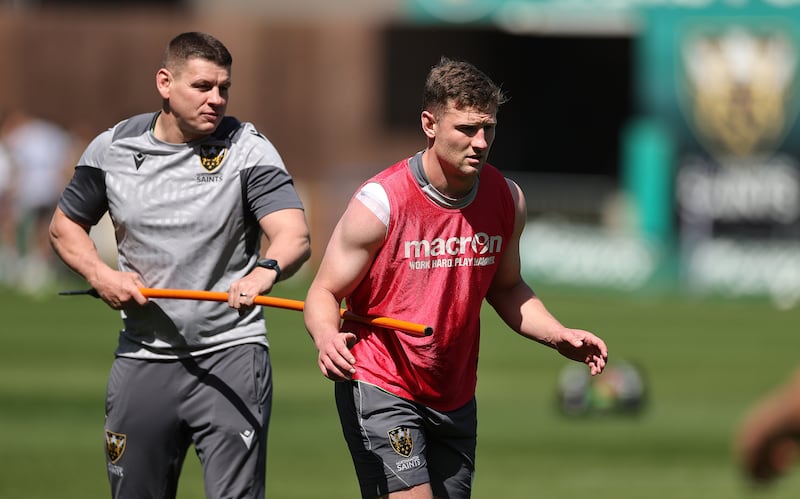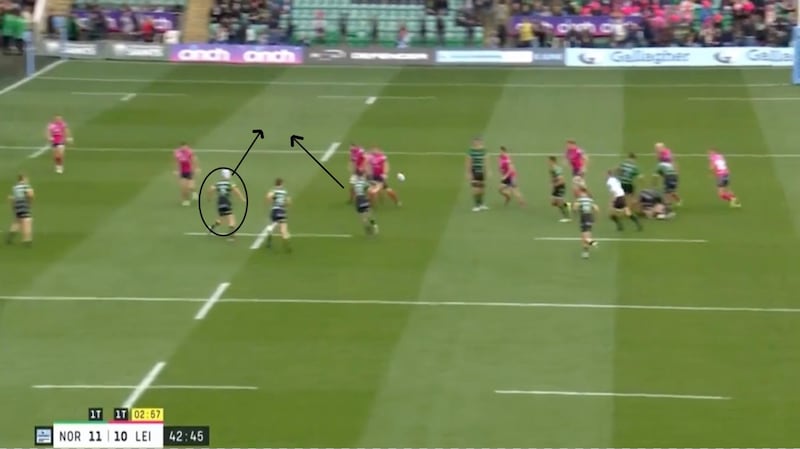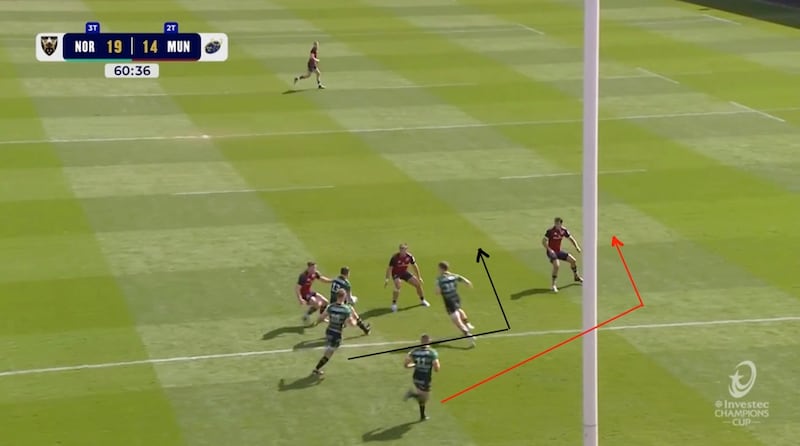For all the talk of the venue, ticket sales and history lessons, once the actual rugby starts, Saturday’s Champions Cup semi-final between Leinster and Northampton represents an intriguing clash of reasonably similar rugby styles.
Both Croke Park combatants are renowned for their attack. Both coaching staffs preach playing with the ball rather than without it. Go through the highlights of each side this season. Well-manufactured set-piece tries and counter-attacking flair are in no short supply. Both teams rely on their international scrumhalves, Jamison Gibson-Park and Alex Mitchell, to set the tone in attack.
On the other side of the ball, both defence coaches call on their charges to flood the breakdown. The stylistic overlap will intrigue tactical gurus. Will we see an end-to-end, basketball-style game, or will the similarities lead to two teams cancelling each other out?
“That’ll be a really interesting dynamic, won’t it?” says Sam Vesty, Northampton’s head coach. “I agree with you on all those points. We’re going to be trying to put the best of us on the pitch and they’ll do the same.”
The similarities extend to both teams hiring new defence coaches in advance of this season. Under Jacques Nienaber, Leinster have revamped their system, pouncing on more breakdowns than before while significantly ramping up their line speed.

Northampton head coach Sam Vesty on meeting Leinster at Croke Park
The Saints, under their new defence coach Lee Radford, haven’t changed their structure per se. Like Leinster, they flood the breakdown, but their speed off the line isn’t as quick.
“We go hard at the ball, we want to get the ball back but we don’t massively go after line speed,” explains Vesty. “Not like you see England and Exeter, or South Africa, or perhaps a Leinster defence. We are more concerned with being connected. Once that line is connected, it’s going to go forward as hard as it can.”
The connectivity is effective. According to analyst Carrick Blake, Saints rank towards the top of the Premiership for hitting attackers behind the gainline.
The new combination, a flowing attack first developed under the tutelage of former boss Chris Boyd, paired with an improved defensive showing, has elevated Northampton’s standing. Last year, they lost all of their European pool games and finished fourth in the Premiership. This time around, they are favourites to finish top of the league while they find themselves in the Champions Cup last four.
Fraser Dingwall, a key figure in the defensive system at centre, explains the new defensive measures brought in by Radford.
“One was to massively increase our physicality,” he says. “Over the preseason everyone went on quite a big gym programme, there was a lot of weight added to the squad as a whole.

“Then it was more mentality . . . Radders carries a lot of weight in himself and his personality, that’s been a huge factor in our defence improving. He’s someone who the boys want to defend for, the boys crave his respect. We’ve got this mentality of wanting to work hard for the people around you and your defence coach.”
Size clearly matters. Across the top club competitions – URC, Premiership, Top14 and Super Rugby – a bulkier Northampton outfit ranks 10th in the world for their dominant tackle rate (9.5 per cent). Leinster are a handful of spots further down with 9.1 per cent.
“We’ve gone after that for a couple of years now, in recruitment, in our training habits, in our mindset, just got after that extra bit of steel,” says Vesty.
The headline signing of that recent recruitment is Fin Smith, the young England outhalf who joined after Worcester Warriors went under. Yet arguably the shrewdest signing has been hooker Curtis Langdon, another ex-Worcester man whose biggest impact has been in attack.
Prior to last weekend’s action, where Langdon didn’t feature, he ranked highest of all Premiership hookers for defenders beaten, line breaks and tries scored. Quantity is his method in attack, leading his position for carries as well.
Against Leicester a fortnight ago, Langdon scored a try from distance when Saints opted for a hallmark of their attack. Scrumhalf Mitchell spotted runners down the blindside flooding a small space with lots of moving parts, flummoxing the outmatched defenders. The gap opened beautifully for Langdon.
Saints rank fourth in the world for taking phases down the blindside (14.6 per cent). As Vesty explains, part of that is down to Mitchell’s sniping, part is down to the work of others.
“I do think the movement of the boys around Mitch give him opportunities to take those breaks, go and take those short sides. If there are no threats outside, Mitch is going to get double-teamed. But if there are lots of things happening, wingers being in and around him, people offering themselves up, suddenly you can’t double-team Mitch.”

For all that narrow, short-side success, the wider Northampton throw the ball, the more ground they make. When the ball travels 60m from the ruck, they make in the region of six metres per phase. Closer in, that figure virtually halves. Such numbers illustrate dangerous outside backs, but Vesty also gives credit to those playing closer to the ruck.
“That’s because the first bit, we’ll hold the defenders in tighter. It’s sort of counterintuitive but you do a better job if you’re more accurate at the line. Ireland are brilliant at this, they’re so aggressive in and around their tighter defenders, the defenders have to sit, conserving space on the edges and there’s more space to run into.”
Munster saw this ability to suck in defenders first hand during their round of 16 clash with the English side. During their victory, Northampton scored an 80-metre try off a lineout. The backline’s ability to draw would-be tacklers into midfield before spreading the ball wide was, in that case, deadly.
While Saints score roughly 55 per cent of their tries from lineouts, they also offer balance. Close to a quarter of their scores come from broken field counterattacks.
“There’s three ways you get the ball, set piece, transition and kick,” explains Vesty. “You have to make sure you’re good and you’ve got a plan off all of those, but the plans are very loose.
“As a philosophy we want the game to go forward, the ball to go forward. The way we go about that is, there are 13 defenders in a line, there’s gonna be 14 holes. We want to be threats in all of those holes going forward.”

For all the talk of scintillating attack, it hasn’t been enough for Saints to beat Leinster in their three European meetings since 2019. Regardless, Vesty acknowledges that, armed with a better defence and the second most accurate lineout in club rugby, this is the strongest Saints have been in recent memory.
“We’re a better team,” he says. “We’re a tougher team. We believe – gosh that was cheesy, that’s from Ted Lasso! But it’s true. We’ve got confidence from that belief that is there.
“We’re the best version of us we’ve been in a good while.”
















